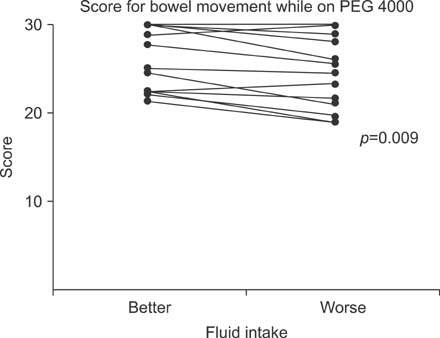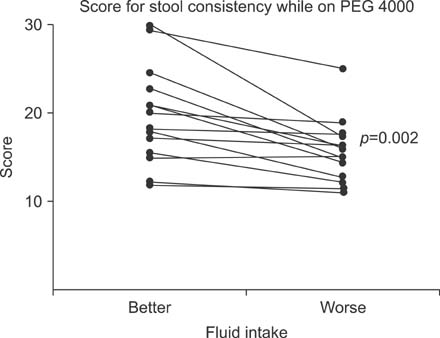Pediatr Gastroenterol Hepatol Nutr.
2014 Dec;17(4):203-208. 10.5223/pghn.2014.17.4.203.
Diets for Constipation
- Affiliations
-
- 1Department of Pediatrics, Konkuk University School of Medicine, Seoul, Korea. baedori@hanafos.com
- KMID: 2315493
- DOI: http://doi.org/10.5223/pghn.2014.17.4.203
Abstract
- Chronic constipation is a very common disease in children. Successful treatment of constipation can be achieved not only with medication but also with lifestyle changes, including a proper diet. Diets including fruits, fluids, and probiotics are good for constipation. Some dietary components are helpful for constipation, and some are harmful. In this study, we present diets related to constipation from the literature, and propose some perspectives regarding diets related to constipation.
Keyword
Figure
Reference
-
1. Williams CL. Importance of dietary fiber in childhood. J Am Diet Assoc. 1995; 95:1140–1146.
Article2. Food and Nutrition Board, Institute of Medicine. Dietary reference intakes for energy, carbohydrates, fiber, fat, fatty acids, cholesterol, protein, and amino acids. Washington, DC: National Academies Press;2005.3. Committee on Nutrition, American Academy of Pediatrics. Pediatric Nutrition Handbook. 4th ed. Elk Grove Village, IL: American Academy of Pediatrics;1998.4. McRorie JW, Daggy BP, Morel JG, Diersing PS, Miner PB, Robinson M. Psyllium is superior to docusate sodium for treatment of chronic constipation. Aliment Pharmacol Ther. 1998; 12:491–497.
Article5. Cummings JH, Macfarlane GT. The control and consequences of bacterial fermentation in the human colon. J Appl Bacteriol. 1991; 70:443–459.
Article6. Topping DL, Clifton PM. Short-chain fatty acids and human colonic function: roles of resistant starch and non-starch polysaccharides. Physiol Rev. 2001; 81:1031–1064.
Article7. Eswaran S, Muir J, Chey WD. Fiber and functional gastrointestinal disorders. Am J Gastroenterol. 2013; 108:718–727.
Article8. Lee WT, Ip KS, Chan JS, Lui NW, Young BW. Increased prevalence of constipation in pre-school children is attributable to under-consumption of plant foods: a community-based study. J Paediatr Child Health. 2008; 44:170–175.
Article9. Morais MB, Vítolo MR, Aguirre AN, Fagundes-Neto U. Measurement of low dietary fiber intake as a risk factor for chronic constipation in children. J Pediatr Gastroenterol Nutr. 1999; 29:132–135.
Article10. Hongisto SM, Paajanen L, Saxelin M, Korpela R. A combination of fibre-rich rye bread and yoghurt containing Lactobacillus GG improves bowel function in women with self-reported constipation. Eur J Clin Nutr. 2006; 60:319–324.
Article11. Badiali D, Corazziari E, Habib FI, Tomei E, Bausano G, Magrini P, et al. Effect of wheat bran in treatment of chronic nonorganic constipation. A double-blind controlled trial. Dig Dis Sci. 1995; 40:349–356.12. Attaluri A, Donahoe R, Valestin J, Brown K, Rao SS. Randomised clinical trial: dried plums (prunes) vs. psyllium for constipation. Aliment Pharmacol Ther. 2011; 33:822–828.
Article13. Loening-Baucke V, Miele E, Staiano A. Fiber (glucomannan) is beneficial in the treatment of childhood constipation. Pediatrics. 2004; 113:e259–e264.
Article14. Chmielewska A, Horvath A, Dziechciarz P, Szajewska H. Glucomannan is not effective for the treatment of functional constipation in children: a double-blind, placebo-controlled, randomized trial. Clin Nutr. 2011; 30:462–468.
Article15. Tabbers MM, DiLorenzo C, Berger MY, Faure C, Langendam MW, Nurko S, et al. Evaluation and treatment of functional constipation in infants and children: evidence-based recommendations from ESPGHAN and NASPGHAN. J Pediatr Gastroenterol Nutr. 2014; 58:258–274.
Article16. Harrell LE, Chang EB. Intestinal water and electrolyte transport. In : Feldman M, Friedman LS, Brandt LJ, editors. Sleisenger and Fordtran's gastrointestinal and liver disease. 8th ed. Philadelphia: Saunders Elservier Co.;2006. p. 2127–2146.17. Kneepkens CM, Hoekstra JH. Chronic nonspecific diarrhea of childhood: pathophysiology and management. Pediatr Clin North Am. 1996; 43:375–390.18. Bae SH, Son JS, Lee R. Effect of fluid intake on the outcome of constipation in children: PEG 4000 versus lactulose. Pediatr Int. 2010; 52:594–597.
Article19. Lacy BE, Levy LC. Lubiprostone: a chloride channel activator. J Clin Gastroenterol. 2007; 41:345–351.20. Blackshaw LA, Brierley SM. Emerging receptor target in the pharmacotherapy of irritable bowel syndrome with constipation. Expert Rev Gastroenterol Hepatol. 2013; 7:5 Suppl 1. 15–19.
Article21. Zoppi G, Cinquetti M, Luciano A, Benini A, Muner A, Bertazzoni Minelli E. The intestinal ecosystem in chronic functional constipation. Acta Paediatr. 1998; 87:836–841.
Article22. Quigley EM. Probiotics in the management of functional bowel disorders: promise fulfilled? Gastroenterol Clin North Am. 2012; 41:805–819.23. Coccorullo P, Strisciuglio C, Martinelli M, Miele E, Greco L, Staiano A. Lactobacillus reuteri (DSM 17938) in infants with functional chronic constipation: a double-blind, randomized, placebo-controlled study. J Pediatr. 2010; 157:598–602.
Article24. Bekkali NL, Bongers ME, Van den Berg MM, Liem O, Benninga MA. The role of a probiotics mixture in the treatment of childhood constipation: a pilot study. Nutr J. 2007; 6:17.
Article25. Banaszkiewicz A, Szajewska H. Ineffectiveness of Lactobacillus GG as an adjunct to lactulose for the treatment of constipation in children: a double-blind, placebo-controlled randomized trial. J Pediatr. 2005; 146:364–369.
Article26. Quinlan PT, Lockton S, Irwin J, Lucas AL. The relationship between stool hardness and stool composition in breast- and formula-fed infants. J Pediatr Gastroenterol Nutr. 1995; 20:81–90.
Article27. Crowley ET, Williams LT, Roberts TK, Dunstan RH, Jones PD. Does milk cause constipation? A crossover dietary trial. Nutrients. 2013; 5:253–266.
Article28. Ida S, Ikeda K, Etani Y, Shouji Y, Yamada H, Kawahara H, et al. Chronic constipation as a symptom of cow's milk allergy in infants and children in Japan [abstract]. Taipei: The 4th World Congress of Pediatric Gastroenterology, Hepatology and Nutrition;2012. p. 152.29. Lee JH, Choe YH, Lee SK, Seo JM, Kim JH, Suh YL. Allergic proctitis and abdominal distention mimicking Hirschsprung's disease in infants. Acta Paediatr. 2007; 96:1784–1789.
Article30. Drummond L, Gearry RB. Kiwifruit modulation of gastrointestinal motility. Adv Food Nutr Res. 2013; 68:219–232.
Article31. Na JR, Oh KN, Park SU, Bae D, Choi EJ, Jung MA, et al. The laxative effects of Maesil (Prunus mume Siebold & Zucc.) on constipation induced by a low-fibre diet in a rat model. Int J Food Sci Nutr. 2013; 64:333–345.
Article32. Bubba MD, Giordani E, Pippucci L, Cincinelli A, Checchini L, Galvan P. Changes in tannins, ascorbic acid and sugar content in astringent persimmons during on-tree growth and ripening and in response to different postharvest treatments. J Food Compos Anal. 2009; 22:668–677.
Article33. Shiga TM, Soares CA, Nascimento JR, Purgatto E, Lajolo FM, Cordenunsi BR. Ripening-associated changes in the amounts of starch and non-starch polysaccharides and their contributions to fruit softening in three banana cultivars. J Sci Food Agric. 2011; 91:1511–1516.
Article
- Full Text Links
- Actions
-
Cited
- CITED
-
- Close
- Share
- Similar articles
-
- Constipation in Children
- Current Status of Translational Research on Constipation
- Guideline for Prevention of Constipation in Korean Elderly: Local Adaptation of the NGC(TM) Guideline for Prevention of Constipation in the Old Adult Population
- Pharmacological Management of Chronic Functional Constipation
- Diagnosis and Treatment of Constipation



